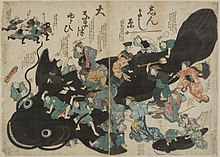Ansei Edo earthquake, 1855
| Ansei Edo earthquake, 1855 | ||
|---|---|---|
|
|
||
| date | November 11, 1855 | |
| Time | 22 O `clock | |
| Magnitude | 7.0 M S | |
| epicenter | 35 ° 39 ′ 0 ″ N , 139 ° 48 ′ 0 ″ E | |
| country | Japan | |
| Affected places | ||
| dead | 7,000 to 10,000 | |
|
|
||
The Ansei Edo earthquake ( Japanese 安 政 江 戸 地震 ) was an earthquake in Japan on November 11, 1855 ( traditional date : Ansei 2/10/2) at 10 p.m. The epicenter was located directly below Edo , today's Tokyo . Although the estimated strength of 6.9 to 7.1 on the surface wave magnitude scale was comparatively low, the number of deaths was solely on the civilian side due to the dense development and the fact that Edo was already over a million at that time Population numbers among the largest cities in the world range from 7,000 to 10,000. In addition, over 50,000 buildings and around 50 temples were destroyed. The damage to residential buildings, palaces and department stores was also significant: at least 14,000 buildings were destroyed during the main nocturnal earthquake and more than 80 aftershocks every day , which only subsided nine days later.
Namazu-e
The representation of this misfortune can also be found on many “catfish pictures” ( Namazu-e ). "The story of the great Namazu in Shin-Yoshiwara " ( し ん よ し 原 大 な ま ず ゆ ひ , Shin-Yoshiwara Ōnamazu yūhi [= yūrai] ), printed in 1855, shows the prostitutes supported by men, as they are with poles and shamisen on the already beaten Namazu (catfish). The characters in the graphic represent the four cardinal points and the center. According to the text, this print serves as an earthquake talisman. On the lower right of the print, rather inconspicuous, you can see children working on a small catfish with tobacco pipes .
Victims and profiteers
The tools represent groups benefiting from the earthquake. The entertainment and brothel district of Shin-Yoshiwara ( 新 吉 原 ) was hit particularly badly . In order to prevent the expensive goods - in the form of prostitutes - from running away from their masters, the entire area was surrounded by a moat and only accessible through a single gate. However, since it caught fire after the quake, all prostitutes and visitors to the neighborhood were locked in and had to face the death in flames. Unfortunately, many brothel owners also decided to lock themselves and all brothel employees in underground storage rooms. This might protect against falling beams, but not fire.
Ō-namazu nochi no namayoi - drunkenness after the earthquake (Namazu)
In addition to the many population groups whose livelihoods had been completely destroyed, there were also groups who were able to benefit from the disaster:
“The earthquake had harmed some social groups while benefiting others. [...] One's occupation became the critical factor in viewing the earthquake as either a setback or an opportunity for profit. "
“The earthquake harmed some social groups and helped others. [...] The job of the individual was the critical factor, whether one saw the earthquake as a setback or an opportunity to profit. "
These groups are represented on many of the Namazu-e created during this period . Mainly craftsmen who worked in the construction industry, raw material dealers and producers, but also sellers of ready-made foods and prostitutes who worked outside the state-licensed Freudenviertel were among the groups that benefited from the earthquake.
Web links
Individual evidence
- ↑ National Geophysical Data Center (as of: 2012/09/30).
- ^ A b Gregory Smits: Shaking up Japan: Edo Society and the 1855 Catfish Picture Prints. (2006) In: Journal of Social History 39/4. Pp. 1045-1078.
- ↑ David Bressan: Namazu: The Earthshaker , History of Geology, January 24, 2011.
- ↑ Stephan Köhn: Reports on what was seen and heard from the Ansei period: Kanagaki Robuns (1829-1894) report on the great Ansei earthquake in 1855 as a representative of the genre of "catastrophe depictions". Wiesbaden 2002.


